Leica SL User Guide

LEICA SL
Instructions
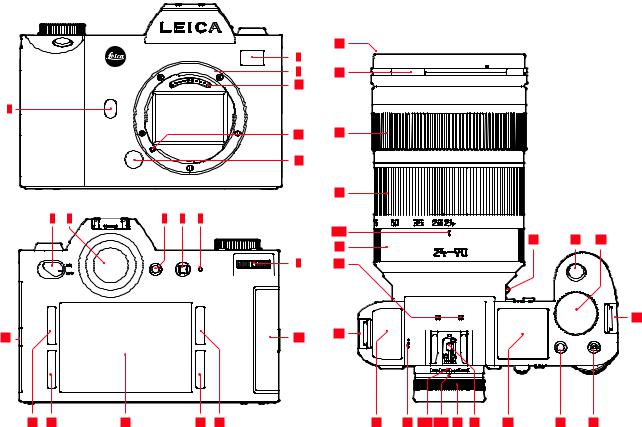
|
|
|
|
|
23 |
|
|
|
|
2 |
|
|
|
|
|
3 |
22 |
|
|
|
|
3a |
|
1 |
|
|
|
|
|
|
|
|
|
3b |
21 |
|
|
|
|
3c |
|
|
|
|
|
|
20 |
4 |
5 |
6 |
7 |
8 |
|
20a |
24 |
25 |
26 |
|
19 |
||||
|
|
|
|
|
|
|
|
9 |
18 |
|
|
|
|
|
|
|
|
|
|
|
|
|
|
|
|
17 |
16 |
|
|
|
|
10 |
17 |
|
|
|
|
|
|
|
|
|
|
|
|
|
|
|
||
15 |
14 |
13 |
12 |
11 |
|
33 |
32 31b 31a 31 |
30 |
29 |
28 |
27 |
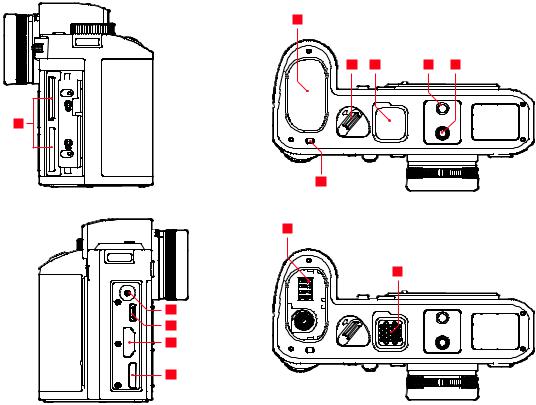
39
40 |
41 |
42 |
43 |
34
44
45
46 |
35 |
36 |
37 |
38 |

EN
Foreword/Scope of Delivery
146
FOREWORD
Dear Customer,
Leica would like to thank you for purchasing the Leica SL and congratulate you on your choice. With this unique digital 35 mm system camera, you have made an excellent choice.
We wish you a great deal of pleasure and success using your new Leica SL. In order to make best use of all the opportunities offered by this high performance camera, we recommend that you first read these instructions.
Your Leica Camera AG
Meaning of the different categories of information in these instructions
Note:
Additional information
Important:
Failure to observe the instructions may result in damage to the camera, the accessories or the pictures.
Attention:
Failure to observe the instructions may cause personal injury.
SCOPE OF DELIVERY
Before using your Leica SL for the first time, please check that the supplied parts are complete.
a.Carrying strap professional
b.Camera bayonet cover
c.Lithium-ion battery Leica BP-SCL4
d.Charger Leica BC-SCL4, including power cable (EU, US)
e.USB 3.0 micro-B cable
f.Lens/display cleaning cloth
g.Cover for contact array in baseplate
h.Leica SL App (for remote control and transfer of recordings with tablet or smartphone, free download in Apple® AppStore®/Google® Play Store®)
i.Leica Image Shuttle (software for remote control with computer, free download)
Attention:
Store small parts (such as the cover for the contact array in the baseplate) as follows:
•out of reach of children (swallowing can result in suffocation!)
•in a place where they will not be lost, e.g. in the places in the camera packaging designed for this purpose
Subject to changes in design and production.
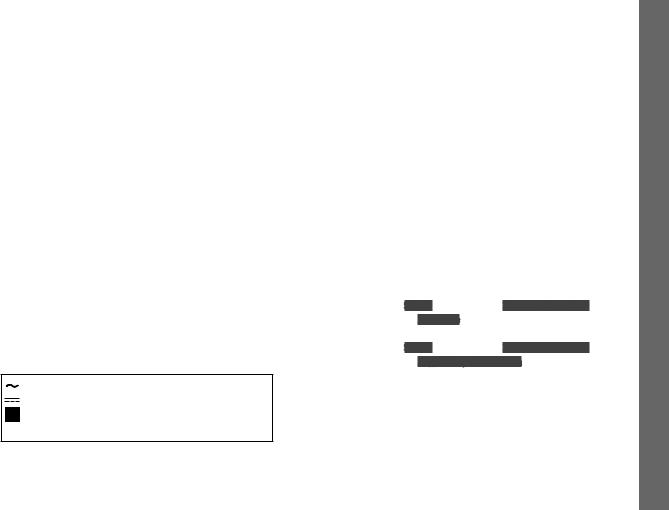
ACCESSORIES
Please visit the Leica Camera AG website for information on the
extensive Leica SL range: www.leica-camera.com
Important:
Only the accessories specified and described in these instructions, and/or by Leica Camera AG, may be used with the Leica SL.
SPARE PARTS |
Order No. |
Camera bayonet cover......................................................... |
16060 |
Camera Carrying Strap Professional, Cordura...................... |
16037 |
Rechargeable Li-ion Battery BP-SCL4................................... |
16062 |
Battery Charger BC-SCL4 (including mains cables US |
|
[423-116.001-020] and EU [423-116.001-005], |
|
others depending on local market)....................................... |
16065 |
USB 3.0 micro-B cable, 3 m................................................. |
16071 |
Cover for contact array in baseplate.................... |
470-601.001-014 |
The symbols on this product (including accessories) have the following meanings:
Alternating current (AC)
Direct current (DC)
Class II devices
(the product has a double-insulated design)
NOTES |
EN |
•As digital cameras have many functions that are controlled electronically, improvements and enhancements to the functions can be installed on the camera at a later date.
•To do this, Leica releases what are known as firmware updates. Cameras are always supplied from the factory with the latest firmware. But you can download it from our website and transfer it to your camera: if you register as an owner on the Leica Camera home page, you will receive a newsletter informing you when a new firmware update is available. Further information on registration and firmware updates for your camera, as well as any amendments and additions to the details provided in these instructions, can be found in the "Owners' Login" area at: https://owners.leica-camera.com
•The information in these instructions refers to a firmware version 2.0. Instructions and explanations of changes due to different firmware versions can also be found in the “Customer area”.
•You can find out which firmware version your camera is fitted with (also see p. 168-173, 265) as follows:
1. In the menu's SETUP section, select Camera Information, and 2. in the sub-menu, Firmware.
•To find specific approvals for this product:
1. In the menu's SETUP section, select Camera Information, and 2. in the sub-menu, Regulatory Information.
•The production date of your camera can be found on the stickers in the warranty card and/or on the packaging. The date is written as follows: Year/Month/Day
147

EN
Table of Contents
TABLE OF CONTENTS |
|
FOREWORD......................................................................................... |
146 |
SCOPE OF DELIVERY........................................................................... |
146 |
ACCESSORIES..................................................................................... |
147 |
SPARE PARTS...................................................................................... |
147 |
NOTES.................................................................................................. |
147 |
CE-NOTE.............................................................................................. |
151 |
WARNING NOTES................................................................................ |
152 |
LEGAL NOTICES.................................................................................. |
152 |
DESIGNATION OF PARTS.................................................................... |
154 |
QUICK-START GUIDE........................................................................... |
156 |
DETAILED INSTRUCTIONS |
|
PREPARATION |
|
ATTACHING THE CARRYING STRAP.................................................. |
158 |
CHARGING THE BATTERY................................................................. |
159 |
CHANGING THE BATTERY................................................................ |
162 |
CHANGING THE MEMORY CARD(S)................................................. |
163 |
ATTACHING/DETACHING THE LENS................................................. |
164 |
ADJUSTING THE VIEWFINDER EYEPIECE........................................... |
165 |
TURNING THE CAMERA ON AND OFF............................................. |
166 |
TOP DIAL........................................................................................... |
166 |
CLICK WHEEL................................................................................... |
169 |
MENU CONTROL.............................................................................. |
168 |
DIRECT ACCESS TO MENU ITEMS.................................................... |
174 |
THE FAVORITES MENU .................................................................. |
176 |
BASIC CAMERA SETTINGS............................................................... |
178 |
MENU LANGUAGE........................................................................... |
178 |
DATE AND TIME............................................................................... |
178 |
ENERGY-SAVING SETTINGS............................................................. |
180 |
MONITOR/VIEWFINDER SETTINGS.................................................. |
180 |
ACOUSTIC SIGNALS........................................................................ |
181 |
BUTTON FUNCTION DISPLAYS......................................................... |
181 |
DISPLAY OPTIONS........................................................................... |
182 |
Histogram and clipping/zebra....................................................... |
182 |
Grid and horizon........................................................................... |
184 |
Focus Peaking.............................................................................. |
184 |
DISABLING THE DIAL AND THE WHEEL......................................... |
185 |
MEMORY CARD MANAGEMENT....................................................... |
185 |
BASIC PHOTO SETTINGS................................................................. |
186 |
SWITCHING THE SENSOR FORMAT.................................................. |
186 |
ASPECT RATIO................................................................................. |
186 |
FILE FORMAT................................................................................... |
187 |
JPEG SETTINGS................................................................................ |
187 |
Resolution.................................................................................... |
187 |
Contrast, saturation, sharpness.................................................... |
188 |
Working color range...................................................................... |
189 |
Noise reduction............................................................................ |
189 |
WHITE BALANCE............................................................................. |
190 |
ISO SENSITIVITY.............................................................................. |
194 |
IMAGE STABILIZATION..................................................................... |
196 |
148

PHOTO RECORDING MODE........................................................... |
198 |
SHUTTER RELEASE BUTTON............................................................ |
198 |
Locking the shutter release and video recording buttons............... |
199 |
Serial exposures........................................................................... |
200 |
FOCUSING...................................................................................... |
201 |
Focusing modes.............................................................................. |
201 |
Automatic focusing/Autofocus modes....................................... |
201 |
Focusing range limitation........................................................ |
202 |
Manual ‘overriding' of the AF setting....................................... |
203 |
AF auxiliary light...................................................................... |
203 |
Autofocus metering methods and operating modes................. |
204 |
Single field-Metering [1 Point].............................................. |
204 |
Field-Metering [Field]........................................................... |
205 |
9 field-Metering [Zone]......................................................... |
205 |
Static................................................................................... |
206 |
Dynamic (Tracking).............................................................. |
206 |
Auto (Face detection)........................................................... |
207 |
Touch-controlled autofocus.................................................. |
207 |
Manual focusing - MF................................................................. |
208 |
Enlarged details as aids for focusing........................................... |
209 |
EXPOSURE METERING AND CONTROL............................................. |
210 |
Exposure metering methods.......................................................... |
210 |
Multi-field metering.................................................................... |
210 |
Center weighted metering.......................................................... |
210 |
Spot metering............................................................................ |
210 |
Exposure control........................................................................... |
211 |
Selecting modes P, A, T, M......................................................... |
211 |
Click wheel and top dial operation during recording mode.......... |
212 |
Electronic shutter...................................................................... |
213 |
Exposure preview....................................................................... |
214 |
Simulation of the effect.............................................................. |
214 |
Automatic program mode - P...................................................... |
216 |
Program shift............................................................................. |
216 |
Aperture priority mode - A.......................................................... |
217 |
Shutter speed priority mode - T.................................................. |
217 |
Metering memory lock............................................................... |
218 |
Exposure compensation setting – M........................................... |
221 |
Automatic bracketing................................................................. |
222 |
FLASH PHOTOGRAPHY................................................................. |
223 |
EN
Contents of Table
149

EN
Table of Contents
VIDEO RECORDINGS........................................................................ |
226 |
FILE FORMAT AND RESOLUTION..................................................... |
226 |
ISO SENSITIVITY.............................................................................. |
226 |
DISTANCE SETTING......................................................................... |
226 |
EXPOSURE METERING METHODS.................................................... |
226 |
EXPOSURE MODES......................................................................... |
227 |
COLOR RANGE................................................................................ |
227 |
CONTRAST, SATURATION, SHARPNESS........................................... |
227 |
STABILIZATION................................................................................ |
227 |
GAMMA L-LOG................................................................................ |
227 |
TIME CODE...................................................................................... |
228 |
VIDEO ASPECT RATIO...................................................................... |
229 |
VIDEO SAFETY AREA....................................................................... |
229 |
AUTO ISO VIDEO............................................................................. |
229 |
VIDEO PREVIEW MODE.................................................................... |
230 |
SOUND RECORDING....................................................................... |
230 |
STARTING/ENDING THE RECORDING.............................................. |
232 |
Recording on an external device.................................................... |
233 |
Locking the shutter release.............................................................. |
233 |
TAKING PICTURES WHILE RECORDING VIDEO................................. |
233 |
ADDITIONAL RECORDING FUNCTIONS |
|
INTERVAL PICTURES........................................................................ |
234 |
TAKING PHOTOGRAPHS WITH THE SELF-TIMER............................... |
236 |
LENS PROFILES............................................................................... |
237 |
REVIEW MODE |
|
AUTOMATIC REVIEW OF LAST PICTURE........................................... |
238 |
REVIEW FOR UNLIMITED TIME......................................................... |
238 |
SELECTING/SCROLLING THROUGH RECORDINGS.......................... |
239 |
ENLARGING PHOTOS....................................................................... |
240 |
MOVING AN ENLARGED SECTION................................................... |
241 |
SIMULTANEOUS DISPLAY OF 12/30 RECORDINGS......................... |
241 |
MARKING RECORDINGS.................................................................. |
243 |
DELETING IMAGES.......................................................................... |
244 |
VIDEO REVIEW................................................................................. |
247 |
VIEWING WITH HDMI DEVICES........................................................ |
250 |
ADDITIONAL FUNCTIONS |
|
USER PROFILES............................................................................... |
252 |
CHANGING FILE NAMES.................................................................. |
254 |
RESETTING ALL MENU SETTINGS.................................................... |
255 |
COPYRIGHT PROTECTION................................................................ |
255 |
GPS AND GEOTAGGING................................................................... |
256 |
FORMATTING MEMORY CARD(S)..................................................... |
258 |
RESET RECORDING NUMBERS........................................................ |
259 |
MISCELLANEOUS |
|
TRANSFERRING DATA TO A COMPUTER ........................................ |
260 |
WIRELESS DATA TRANSMISSION AND |
|
REMOTE CONTROL OF THE CAMERA.............................................. |
261 |
USING RAW DATA (DNG).................................................................. |
264 |
INSTALLING FIRMWARE UPDATES.................................................. |
265 |
SAFETY AND CARE INSTRUCTIONS................................................... |
266 |
INDEX.................................................................................................. |
274 |
APPENDIX |
|
DISPLAYS.......................................................................................... |
276 |
GESTURE CONTROL......................................................................... |
283 |
MENU LIST....................................................................................... |
284 |
TECHNICAL DATA................................................................................ |
286 |
LEICA SERVICE ADDRESSES.............................................................. |
288 |
150

CE NOTE
The CE identification of our products documents compliance with the fundamental requirements of the applicable EU directives.
Declaration of Conformity (DoC)
Hereby, “Leica Camera AG” declares that this product is in compliance with the essential requirements and other relevant provisions of Directive 2014/53/EU. Customers can download a copy of the original DoC to our R&TTE products from our DoC server:
www.cert.leica-camera.com
In case of further questions, please contact:
Leica Camera AG, Am Leitz-Park 5, 35578 Wetzlar, Germany
This product is intended for general consumer. (Category 3)
This product on purpose to connect to access point of 2.4 GHz WLAN.
DISPOSAL OF ELECTRICAL AND ELECTRONIC EQUIPMENT
(Applies within the EU, and other European countries with segregated waste collection systems)
This device contains electrical and/or electronic components and must therefore not be disposed of in general household waste! Instead, it should be disposed of at a recycling collection point provided by the local authority. This costs you nothing.
If the device contains standard or rechargeable batteries, these must be removed first and also be disposed of in line with relevant regulations. Further information on the subject is available from your local administration, your local waste collection company, or in the store where you purchased this device.
WARNING NOTES
•Modern electronic components react sensitively to electrostatic discharge. As people can easily pick up charges of tens of thousands of volts, by walking on synthetic carpets for example, a discharge can occur when you touch your camera, particularly if it is placed on a conductive surface. If only the camera housing is affected, this discharge is harmless to the electronics. However, despite built-in safety circuits, the outer contacts, such as those on the base of the camera, should not be touched if at all possible for safety reasons.
•For any cleaning of the contacts, do not use an optical micro-fiber cloth (synthetic); use a cotton or linen cloth instead! Before touching the contacts, you can make sure you discharge any electrostatic charge by deliberately touching a heating or water pipe (conductive, grounded material). You can also avoid soiling and oxidization of the contacts by storing your camera in a dry place with the lens or bayonet cover fitted.
•Use only the recommended accessories to prevent faults, short circuits or electric shock.
•Do not attempt to remove parts of the body (covers); qualified repairs can be carried out only at authorized service centers.
EN
Contents of Table
151

EN
Regulatory information
152
LEGAL NOTICES
•Please ensure that you observe copyright laws. The recording and publication of pre-recorded media such as tapes, CDs, or other published or broadcast material may contravene copyright laws. This also applies to all of the software supplied.
•This product incorporates open source software which is distributed in the hope that it will be useful, but without any warranty whatsoever, i.e. without even the implied warranty of merchantability or the software’s applicability for a particular purpose. Please refer to the detailed terms and conditions for this as follows:
1.In the menu's SETUP section, select Camera Information, and
2.select License Information in the sub-menu.
•This product is licensed under the AVC patent portfolio license for the personal and noncommercial use of a consumer to (i) encode video in compliance with the AVC Standard (“AVC Video”) and/or (ii) decode AVC Video that was encoded by a consumer engaged in a personal and non-commercial activity and/or was obtained from a video provider licensed to provide AVC Video. No license is granted or shall be implied for any other use. Additional information may be obtained from MPEG LA, LLC (see http://www.mpegla. com).
•SD, SDHC, and SDXC are trademarks of SD-3C, LLC.
•USB is a trademark of the USB Implementers Forum, Inc.
•HDMI (High-Definition Multimedia Interface) is a trademark or a registered trademark of HDMI Licensing LLC in the United States and other countries.
•Adobe is a trademark or a registered trademark of Adobe Systems Incorporated in the United States and/or other countries.
•Mac is a trademark of Apple Inc., registered in the U.S. and other countries.
•App Store is a service mark of Apple Inc.
•Windows is either a registered trademark or a trademark of Microsoft Corporation in the United States and/or other countries.
•Android and Google Play are trademarks or registered trademarks of Google Inc.
•QR Code is a registered trademark of DENSO WAVE INCORPORATED.
•Other names of systems and products mentioned in these instructions are usually the registered trademarks or trademarks of the manufacturers who developed the system or product concerned.
FOR U.S. ONLY
Contains FCC ID: VPYLBXN604
This device's transmitter must not be co-located or operated in conjunction with any other antenna or transmitter. This device complies with FCC radiation exposure limits set forth for an uncontrolled environment and meets the FCC radio frequency (RF) Exposure Guidelines. This equipment has very low levels of RF energy that are deemed to comply without testing of specific absorption ratio (SAR).
FCC Note:
This device has been tested and found to comply with the limits for a Class B digital device, pursuant to Part 15 of the FCC Rules. These limits are designed to provide reasonable protection against harmful interference in a residential installation. This device generates, uses, and can radiate radio frequency energy and, if not installed and used in accordance with the instructions, may cause harmful interference to radio communications. However, there is no guarantee that interference will not occur in a particular installation.

If this device does cause harmful interference to radio or television reception, which can be determined by turning the equipment off and on, the user is encouraged to try to correct the interference by one or more of the following measures:
•Reorient or relocate the receiving antenna.
•Increase the distance between the equipment and receiver.
•Connect the equipment into an outlet on a circuit different from that to which the receiver is connected.
•Consult the dealer or an experienced radio/TV technician for help.
FCC Caution:
To assure continued compliance, follow the attached installation instructions and use only shielded interface cables with ferrite core when connecting to computer or peripheral devices.
Any changes or modifications not expressly approved by the party responsible for compliance could void the user’s authority to operate this equipment.
Trade Name: |
LEICA |
Model No.: |
LEICA SL (Typ 601) |
Responsible party/ |
Leica Camera Inc. |
support contact: |
1 Pearl Count, Unit A |
|
Allendale, New Jersey 07401 |
|
Tel.: +1 201 995 0051 |
|
Fax: +1 201 995 1684 |
|
technicalinfo@leicacamerausa.com |
This device complies with Part 15 of the FCC Rules. Operation is subject to the following two conditions:
(1)This device may not cause harmful interference.
(2)This device must accept any interference received, including interference that may cause undesired operation.
Leica SL (Typ 601)
Tested To Comply
With FCC Standards
FOR HOME OR OFFICE USE
FOR CANADA ONLY:
CAN ICES-3 (B)/NMB-3(B)
This device complies with RSS-210 of the IC Rules. Operation is subject to the following two conditions:
(1)This device may not cause harmful interference,
(2)This device must accept any interference received, including interference that may cause undesired operation of the device.
This equipment complies with IC radiation exposure limits set forth for an uncontrolled environment and meets RSS-102 of the IC radio frequency (RF) Exposure rules. This equipment complies with IC radiation exposure limits set forth for an uncontrolled environment and meets RSS-102 of the IC radio frequency (RF) Exposure rules.
EN
equipment electronic and electrical of Disposal
153

EN
Designation of Parts
DESIGNATION OF PARTS |
Top view |
|||||||||
Front view |
17 |
|
Carrying strap clip |
|||||||
|
|
|
Microphones |
|||||||
18 |
||||||||||
1 |
|
|
Stop down/FN button |
|
|
|
Fixed ring |
|||
|
|
19 |
||||||||
2 |
|
|
Self timer LED/Sensor for white balance |
|
|
|
Zoom ring with |
|||
|
|
20 |
||||||||
3 |
|
|
Bayonet for lens mounting with |
|
|
|
|
|
Index mark |
|
|
|
|
|
|
a |
|||||
|
|
|
a |
Contact strip |
21 |
|
|
Focusing dial |
||
|
|
|
b |
Locking pin/Index point |
|
|
|
Bayonet for lens hood |
||
|
|
|
22 |
|
||||||
|
|
|
c |
Unlocking button |
|
|
|
Filter thread |
||
|
|
|
23 |
|
||||||
|
|
|
|
|||||||
|
|
|
|
|
|
|
Red alignment button for changing lens |
|||
Rear view |
24 |
|
||||||||
|
|
|
Shutter release button |
|||||||
25 |
|
|||||||||
4 |
|
|
Main switch |
|
|
|
Top dial |
|||
|
|
26 |
|
|||||||
5 |
|
|
Viewfinder |
|
|
|
Video release button |
|||
|
|
27 |
|
|||||||
6 |
|
|
Function button |
|
|
|
LV button |
|||
|
|
28 |
|
|||||||
7 |
|
|
Joystick |
|
|
|
Top panel display |
|||
|
|
29 |
|
|||||||
8 |
|
|
LED for indicating picture mode/recording data on to the |
|
|
|
Accessory shoe |
|||
|
|
30 |
|
|||||||
|
|
|
card/brightness sensor |
|
|
|
Eyecup with |
|||
|
|
|
31 |
|
||||||
9 |
|
|
Click wheel |
|
|
|
|
|
Index mark |
|
|
|
|
|
|
a |
|||||
10 |
|
Door over memory card slots |
|
|
|
|
Diopter setting scale |
|||
|
|
|
|
b |
||||||
11 |
|
Menu control/function button (TR) |
|
|
|
Loudspeaker |
||||
|
32 |
|
||||||||
12 |
|
Menu control/function button (BR) |
|
|
|
GPS Antenna |
||||
|
33 |
|
||||||||
13 |
|
Monitor |
|
|
|
|
|
|
||
|
|
Menu control/function button (BL) |
|
|
|
|
|
|
||
14 |
|
|
|
|
|
|
|
|||
|
|
Menu control/function button (TL) |
|
|
|
|
|
|
||
15 |
|
|
|
|
|
|
|
|||
|
|
Cover over sockets |
|
|
|
|
|
|
||
16 |
|
|
|
|
|
|
|
|||
154

View from right (illustration without door) 34 Memory card slots
View from left (illustration without cover)
35Threaded flash sync socket
36Remote control/headphone/external microphone socket
37HDMI socket
38USB socket
Bottom views
39Battery
40Battery release lever
41Cover over hand grip contacts
42Hole for multi-function hand grip guide pin
43Tripod plate with 1⁄4" thread
44Hole for rotation prevention pin
45Contacts in battery compartment (battery removed)
46Contacts for hand grip (cover removed)
EN
Parts of Designation
155

EN
Quick Start Guide
QUICK START GUIDE
Required parts:
––Camera
––Lens (not supplied)
––Battery
––Charger with appropriate power cable
––Memory card (not supplied)
Note:
The settings recommended here allow you to take good photographs easily, quickly and reliably when you first start to try out the Leica SL. For details of the various modes/functions, refer to the corresponding sections on the specified pages.
Preparation:
1.Attach the lens (see p. 164)
2.Charge the battery (see p. 161)
3.Set the main switch to OFF (see p. 166)
4.Insert the charged battery into the camera (see p. 162)
5.Insert the memory card (see p. 163)
6.Set the main switch to ON (see p. 166)
7.Select your preferred menu language (see p. 178)
8.Set the date and time (see p. 178)1
9.Set the subject focus (see p. 211)
1 Not necessary as supplied because this is done automatically when GPS (see p. 256) is switched on.
156

Taking photographs
1.Press the shutter button to the first pressure point to activate distance setting and exposure metering and to save the values.
2.Push the shutter button all the way down to take the photo.
Viewing photographs:
Press the upper right button next to the monitor.
Depending on the camera's previous status, you may have to press more than once to call up the button function icon ( ) first.
To view other pictures:
Turn the click wheel or press the joystick right or left, or use gesture control (see p. 239/283).
Enlarging pictures:
Turn the top dial or press the joystick right or left, or use gesture control (see p. 240/283).
Deleting pictures:
Press the lower left button next to the monitor and make further settings in the deletion menu.
EN
Guide Start Quick
157
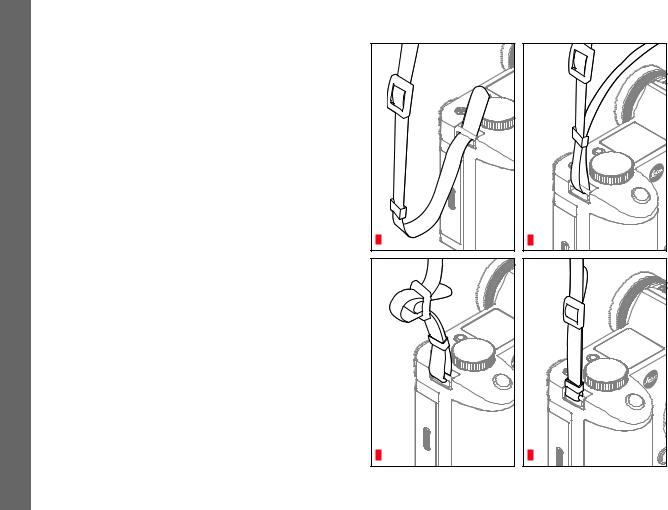
EN
Preparations
158
DETAILED INSTRUCTIONS |
ATTACHING THE CARRYING STRAP |
PREPARATIONS
1 |
3 |
2 |
4 |

CHARGING THE BATTERY
The Leica SL is powered by a Lithium ion battery.
Attention:
•Only the battery type specified and described in these instructions, or battery types specified and described by Leica Camera AG, may be used in this camera.
•These batteries may only be used in the units for which they are designed and may only be charged exactly as described below.
•Using this battery contrary to the instructions and using non-specified battery types can result in an explosion under certain circumstances!
•The batteries must not be exposed to sunlight or heat for prolonged periods, or to humidity or moisture. Likewise, the batteries must not be placed in a microwave oven or a high pressure container as this results in a risk of fire or explosion!
•Damp or wet batteries must not be charged or used in the camera under any circumstances!
•Always ensure that the battery contacts are clean and freely accessible. While lithium ion batteries are protected against short circuits, they should still be protected against contact with metal objects such as paper clips or jewelry. A short-circuited battery can get very hot and cause severe burns.
•If a battery is dropped, check the casing and the contacts immediately for any damage. Using a damaged battery can damage the camera.
•In case of noise, discoloration, deformation, overheating or leaking fluid, the battery must be removed from the camera or charger immediately and replaced. Continued use of the battery results in a risk of overheating, which can cause fire and/or explosion!
•In case of leaking fluid or a smell of burning, keep the battery away from sources of heat. Leaked fluid can catch fire!
•A safety valve in the battery guarantees that any excess pressure caused by improper handling is discharged safely.
•Only the charger specified and described in these instructions, or other chargers specified and described by Leica Camera AG, may be used. The use of other chargers not approved by Leica Camera AG can cause damage to the batteries and, in extreme cases, lead to serious or life-threatening injuries.
•The charger supplied should be used exclusively for charging this battery type. Do not attempt to use it for other purposes.
•Ensure that the power socket used is freely accessible.
•Battery and charger must not be opened. Repairs may only be carried out by authorized service centers.
•Ensure that the batteries cannot be accessed by children.
EN
Preparations
159

EN
Preparations
First Aid:
•Battery fluid coming into contact with the eyes may cause blindness. Rinse the eyes immediately with clear water. Do not rub the eyes! Consult a doctor immediately!
•If leaked fluid gets onto the skin or clothing, there is a risk of injury. Rinse the affected areas with clean water. Obtain medical assistance.
Notes:
•The battery must have a temperature of 0°-35°C/32° - 95°F to be charged (otherwise the charger will not turn on, or will turn off again).
•Lithium ion batteries can be charged at any time, regardless of their current charge level.
•Both battery and charger become warm during charging. This is normal and not a malfunction.
•If the two LEDs flash rapidly (> 2 Hz) after starting charging, this indicates a charging error (e.g. maximum charging time exceeded, voltages or temperatures outside the permitted ranges, or short circuit). In this case, disconnect the charger from the mains and remove the battery. Ensure that the above temperature conditions are met and then restart the charging process. If the problem persists, please contact your dealer, the Leica office in your country or Leica Camera AG.
•Lithium ion batteries should only be stored partly charged, i.e. not when fully discharged or fully charged (see p. 161). If stored for very long periods, it should be charged up and discharged again around once a year.
•Rechargeable lithium ion batteries generate power through internal chemical reactions. This reaction is influenced by ambient temperature and humidity. To ensure a maximum service life of the battery, it should not be exposed to constant extremes (high or low) of temperature (e.g. in a parked car in the summer or winter).
•Even with optimum conditions of use, every battery has a limited service life. After several hundred charging cycles, this becomes noticeable as the operating times get significantly shorter.
•Dispose of damaged batteries in accordance with the relevant regulations (see p. 151) at an approved collection point for proper recycling.
•The replaceable battery provides power to a back-up battery inside the camera. This back-up battery retains the set date and time for up to three months. If this back-up battery becomes discharged it must be recharged by inserting a charged main battery. Once the replaceable battery has been inserted, the full capacity of the back-up battery is recovered after about 60 hours. This process does not require the camera to be turned on. However, you will have to set the date and time again in this situation.
•Remove the battery if you will not be using the camera for a long period of time. Turn the camera off using the main switch before removing the battery (see p. 166). Otherwise, after several weeks the battery could become totally discharged, i.e. the voltage is sharply reduced as the camera still consumes a small amount of current even when it is turned off (e.g. for saving your settings).
160
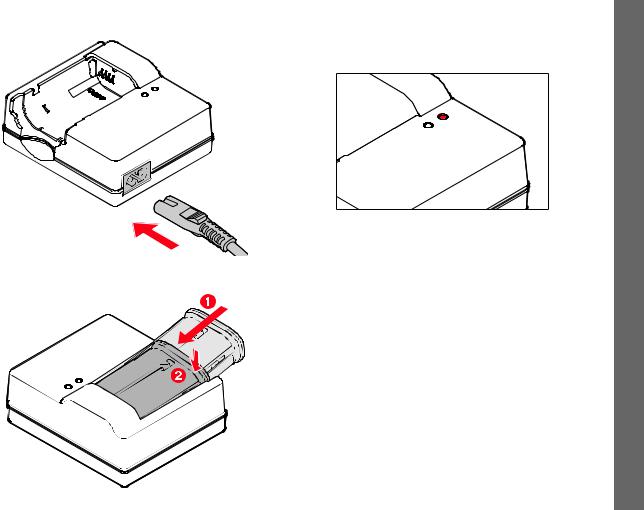
PREPARING THE CHARGER
INSERTING THE BATTERY IN THE CHARGER
CHARGE STATUS DISPLAYS |
EN |
The charging process is indicated by LEDs.
80%CHARGE |
Preparations |
|
–CHARGE LED (green):
Flashing indicates charging in progress.
–80% LED (orange):
Lighting up indicates charge level of 80% has been achieved.
–Both LEDs light up:
Charging has been completed.
Notes:
•The charger switches automatically to the prevailing mains voltage.
•Disconnect the charger from the electrical socket and remove the battery after charging is completed.
161
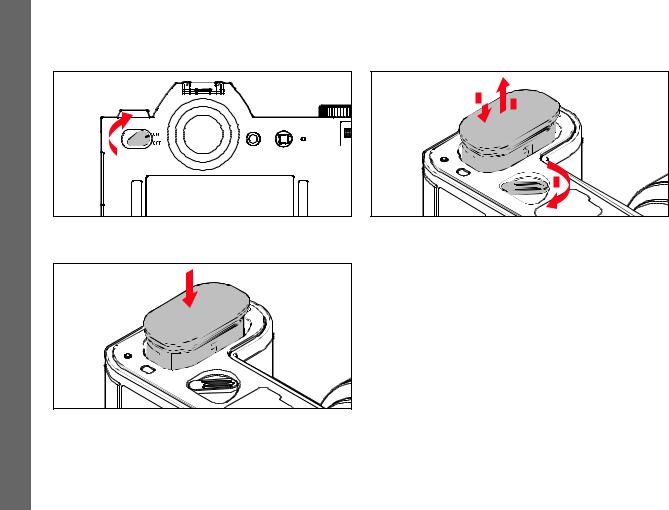
EN CHANGING THE BATTERY
Preparations |
Turn off the camera |
|
Insert the battery
"click" |
Remove the battery
2 |
3 |
|
|
|
1 |
Note:
When the lever is turned, a spring in the battery compartment pushes the battery out so it can be grasped. The locking mechanism has a catch to prevent the battery from accidentally falling further out, even if the camera is held upright.
162
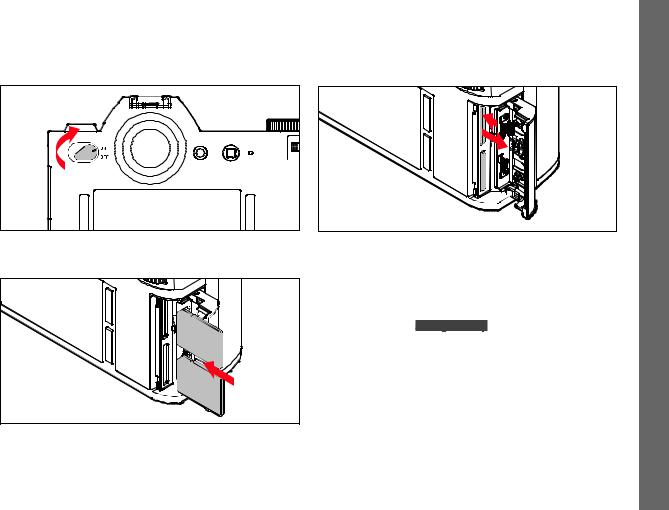
CHANGING THE MEMORY CARD(S)
SD, SDHC or SDXC memory cards can be used in the Leica SL. Turn off the camera
|
|
EN |
Remove the memory card |
|
Preparations |
|
1 |
|
|
|
|
|
|
2 |
Insert the memory card
"click" |
Notes:
The card slots are numbered: Top = 1, Bottom = 2.
–Slot 1 operates according to UHS II standards.
–Slot 2 only according to UHS I standards.
This must be taken into account, e.g. when recording 4k video (see p. 226) and using the Storage Backup-function (see p. 185).
Important:
Do not open the door and do not remove the memory card or the battery while the status LED is lit to indicate that the camera is accessing the memory. Otherwise, the data on the card/s can be destroyed and the camera may malfunction.
163
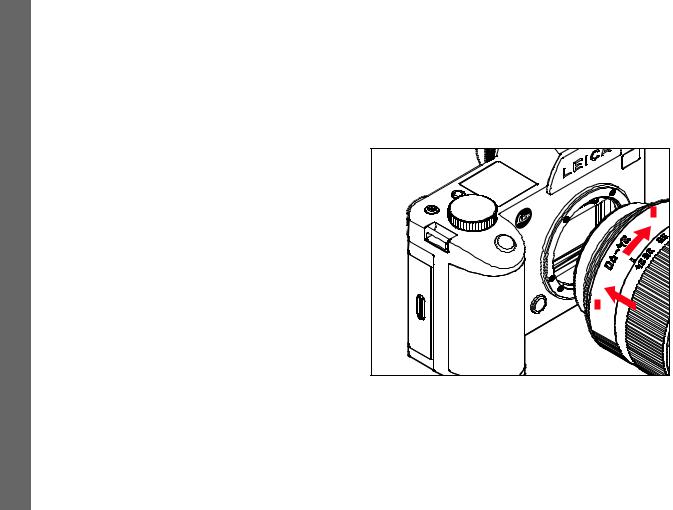
EN
Preparations
Notes:
•SD, SDHC, and SDXC memory cards have a write protection switch, which can be used to prevent unintentional storage and deletion of pictures. This switch takes the form of a slider on the non-beveled side of the card; in the lower position, marked LOCK, the data is protected.
•If a memory card cannot be inserted, check that it is aligned correctly.
•If a memory card is inserted, pictures are only saved on the card.
•The range of SD/SDHC/SDXC cards is too large for Leica Camera AG to be able to completely test all available types for compatibility and quality. Although no damage to the camera or the card is generally expected, because some cards may not fully comply with the SD/SDHC/SDXC standards Leica Camera AG cannot provide any guarantee of function.
A list of recommended memory cards can be found at: https://de.leica-camera.com/Service-Support/Support/ Downloads?category=128327&subcategory=&type=68377& language=68389
•As electromagnetic fields, electrostatic charge, and defects of the camera or the card can lead to damage or loss of the data on the memory card/s, we recommend that you also transfer the data to a computer and save it there.
ATTACHING/DETACHING A LENS
Compatible lenses
In addition to Leica SL lenses, you can also use Leica TL system lenses, as well as Leica M, R and S lenses with the help of adapters available as accessories.
Affixing |
2 |
1 |
164

Removing |
1 |
Notes:
•To protect against dust getting into the interior of the camera, it is important always to have a lens or a cover fitted to the camera body. For the same reason, when changing lenses work quickly and in an environment that is as dust-free as possible.
•Camera or lens rear caps should not be stored in your pants pockets as they attract dust that can get into the camera when they are attached.
ADJUSTING THE VIEWFINDER EYEPIECE |
EN |
The viewfinder can by adjusted from +2 to -4 diopters, so that it is |
|
exactly set to match your eye. While looking at the viewfinder |
Preparations |
image, turn the diopter setting scale until both the image and all |
|
the displays are sharp. |
|
|
165
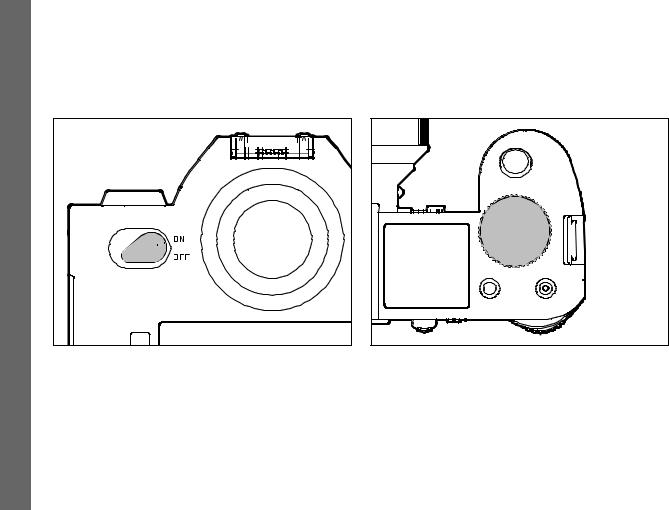
EN TURNING THE CAMERA ON AND OFF
Camera operation |
The Leica SL is turned on and off using the main switch. |
– ON = Turned on |
|
– OFF = Turned off |
|
|
TOP DIAL
In recording mode, the top dial is used mainly to adjust the exposure by changing the shutter speed (see p. 212). In review mode, it is used for different functions (see p. 240/241)
166
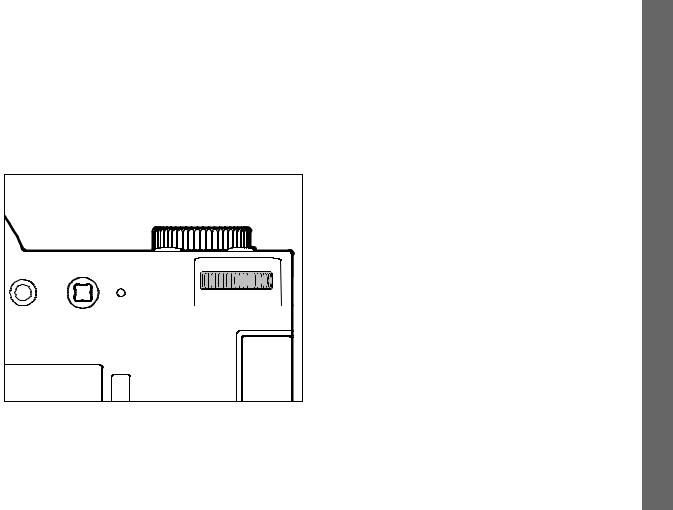
CLICK WHEEL
In recording mode, the rear wheel is used
–to select the exposure control mode (see p. 211), and
–to adjust the exposure by changing the aperture (see p. 217/221).
In review mode, it is used for different functions (see
p. 239-244). During menu control, it is used to navigate within menus and sub-menus, as well as to set and to confirm settings (see p. 169).
EN
operation Camera
167
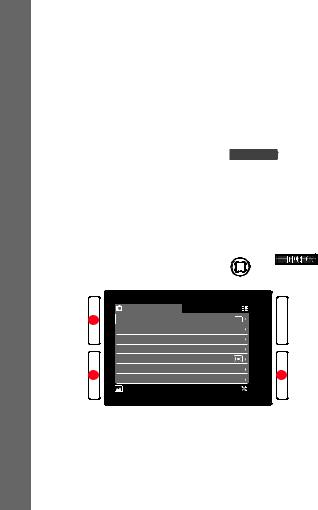
EN
Camera operation
MENU CONTROL
Most of the modes and settings on the Leica SL are operated using menus. Navigation and settings in the whole menu are very quick and simple as
––the menu items in the main menu are divided into three logically grouped function sections that can be accessed directly,
––up to seven buttons for freely assignable menu items can be accessed directly, and
––there is a separate, freely assignable FAVORITES menu.
Calling up the main menu
To call up menu control and directly access the three main menu sections, and also, within the sections, to 'jump' to the individual pages they consist of, you use three of the four buttons located to the left and right of the monitor.
CAMERA |
FAVORITES |
Drive Mode |
|
Focus Mode |
AFs |
AF Mode |
Static |
AF Field Size |
Field |
Exposure Metering |
|
Exposure Compensation |
0 |
Exposure Bracketing |
|
IMAGE |
SETUP |
Notes:
•These four buttons next to the monitor are so-called "soft keys". Outside the normal menu control, e.g. when reviewing pictures in the monitor, they have different functions, indicated by corresponding displays.
The same applies to the upper right button next to the monitor, the function button on the front, the Live View button on the top of the camera, and, where available, to the video recording button.
•During the further course of these instructions, the four buttons next to the monitor will either be identified by stating their specific functions in the relevant situations, or they will be designated as follows:
––TL (top left)
––BL (bottom left)
––TR (top right)
––BR (bottom right)
The Live View button will be designated LV, and the function button FN.
168

Menu settings
All settings of the menu items can also be made with the click wheel or the joystick.
CAMERA |
FAVORITES |
Drive Mode |
|
Focus Mode |
AFs |
AF Mode |
Static |
AF Field Size |
Field |
Exposure Metering |
|
Exposure Compensation |
0 |
Exposure Bracketing |
|
IMAGE |
SETUP |
Exiting the menu
You can exit the menu in various ways:
–to activate photo recording mode:
Tap the shutter release button (see p. 198)
–to take a photo:
Press the shutter release all the way
–to activate video preview mode: Press the LV-button
–to start a video recording:
Press the video release button (see p. 232)
EN
operation Camera
169

EN
Camera operation
Main menu function sections
The menu list is divided into 3 sections:
–
CAMERA |
FAVORITES |
Drive Mode |
|
Focus Mode |
AFs |
AF Mode |
Static |
AF Field Size |
Field |
Exposure Metering |
|
Exposure Compensation |
0 |
Exposure Bracketing |
|
IMAGE |
SETUP |
–
CAMERA |
FAVORITES |
ISO |
Auto ISO |
White Balance |
AWB |
Photo File Format |
DNG |
Photo Aspect Ratio |
3:2 |
Sensor Format |
|
JPEG Resolution |
L-JPG |
JPEG Settings |
|
IMAGE |
SETUP |
–
CAMERA |
FAVORITES |
Storage Backup |
Off |
Edit File Name |
L****** |
Format |
|
Auto Review |
5 s |
Capture Assistants |
|
AF Setup |
|
Live View |
|
IMAGE |
SETUP |
Menu screen
|
|
|
|
|
|
|
|
|
|
CAMERA |
|
1 |
FAVORITES |
|
|
2 |
|
Drive Mode |
|
|
|
4 |
|
|
|
Focus Mode |
3 |
|
AFs |
|
|
|
|
AF Mode |
|
|
Static |
|
|
|
|
AF Field Size |
|
|
Field |
|
|
|
|
Exposure Metering |
|
|
|
|
|
|
|
|
|
|
|
|
|
|
|
Exposure Compensation |
|
|
0 |
5 |
|
|
|
Exposure Bracketing |
|
|
|
|
|
|
|
IMAGE |
|
|
SETUP |
|
|
1 Function section titles: The selected one is indicated by a gray background1
2 Scrollbar: Indicates on which of the 8 pages you are within the main menu item list, the function sections are made up of 2 or 4 pages
3 Menu item name
4 Menu item setting/value: The active menu item is highlighted (white lettering, dark background, underlined in red), this applies to all menu levels
5 Triangle: Indicates the existence of a sub-menu
1 The gray tones are inverted in the FAVORITES menu (see p. 176).
170
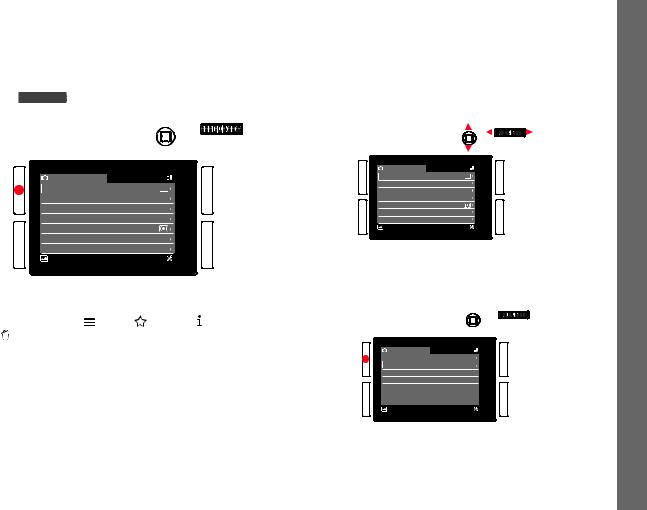
Selecting menu items
1.Select the first page of a menu section by briefly (≤1 s) pressing the respectively marked button: Three times if the button function icons are activated, two times if not
•If you were in recording mode, an intermediate step calls up the FAVORITES menu (see p. 176).
2.To select the individual menu items
––either by turning the click wheel to the right (= scroll down) or to the left (= scroll up),
––or press the joystick up or down.
Using these two controls, the items in all three main menu sections are in one common continuous loop, so they can all be reached in either direction by scrolling through the list.
CAMERA |
FAVORITES |
Drive Mode |
|
Focus Mode |
AFs |
AF Mode |
Static |
AF Field Size |
Field |
Exposure Metering |
|
Exposure Compensation |
0 |
Exposure Bracketing |
|
IMAGE |
SETUP |
•If these are displayed from review mode, the button function symbols valid in this situation are first displayed in an
intermediate step. |
(Menu), |
(Marking), (Displays) and |
(Delete). |
|
|
CAMERA |
FAVORITES |
Drive Mode |
|
Focus Mode |
AFs |
AF Mode |
Static |
AF Field Size |
Field |
Exposure Metering |
|
Exposure Compensation |
0 |
Exposure Bracketing |
|
IMAGE |
SETUP |
To facilitate faster navigation within the three menu sections, it is also possible to 'jump' directly from page to page by pressing the relevant button next to the monitor. In this case, each section is itself arranged as a closed continuous loop.
CAMERA |
FAVORITES |
Interval |
|
Flash Settings |
|
Exp. Preview |
On |
Focus Limit (Macro) |
Off |
Electronic Shutter |
Off |
IMAGE |
SETUP |
EN
operation Camera
171
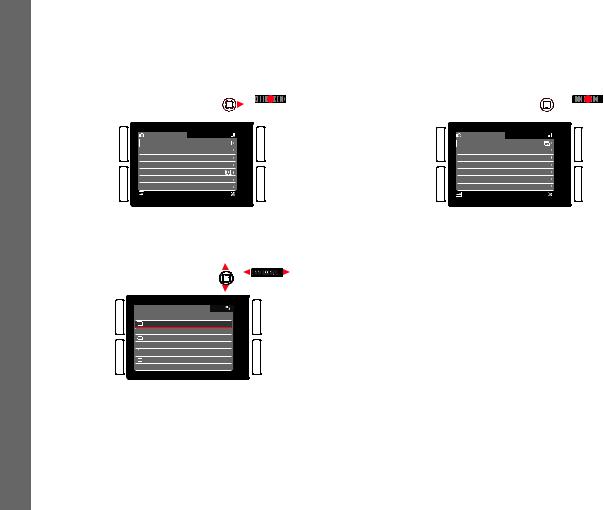
EN
Camera operation
Setting menu items with sub-menu
(with triangle mark on the right)
3.Press the click wheel or the joystick inwards or to the right.
•The sub-menu appears, listing the available options or the values that can be set.
5.Press the click wheel or the joystick inwards to confirm the set option/value.
•The display returns to the next higher menu level, or, for functions that require further settings, advances to the next option.
CAMERA |
FAVORITES |
Drive Mode |
|
Focus Mode |
AFs |
AF Mode |
Static |
AF Field Size |
Field |
Exposure Metering |
|
Exposure Compensation |
0 |
Exposure Bracketing |
|
IMAGE |
SETUP |
CAMERA |
FAVORITES |
Drive Mode |
|
Focus Mode |
AFs |
Exposure Compensation |
0 EV |
Interval |
|
White Balance |
|
Format |
|
User Profile |
|
IMAGE |
SETUP |
4.Turn the click wheel or press the joystick in the relevant direction (different depending on whether you are using a list or a scale) to select the desired option/value.
DRIVE MODE
 Single
Single
 Continuous Low Speed
Continuous Low Speed
 Continuous Medium Speed
Continuous Medium Speed
 Continuous High Speed
Continuous High Speed
 Self Timer 2 s
Self Timer 2 s
 Self Timer 12 s
Self Timer 12 s
 Interval
Interval
 Exposure Bracketing
Exposure Bracketing
172
